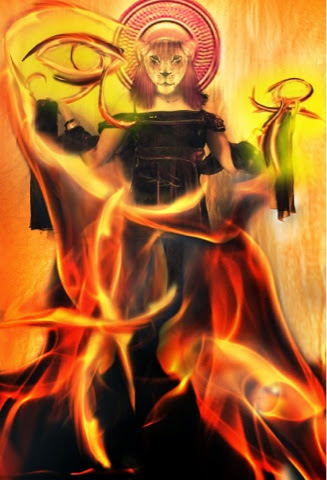- Attributes: A sun goddess. She represents the scorching, burning, destructive heat of the sun. She was a fierce goddess of war, the destroyer of the enemies of Ra and Osiris. Her temper was uncontrollable. In the legend of Ra and Hathor, Sekhmet's anger became so great, she would have destroyed all of mankind if Ra had not taken pity on us. He tricked her by dyeing beer blood-red which she drank believing it to be human blood and became drunk. She soon forgot her anger and we were saved from destruction.
. . . . .Sekhmet was the wife of the creator-god Ptah. This marriage was unusual in that it resulted from geographical proximity of their cults rather than a sharing of attributes.
- Representation: A woman with the head of a lion.
- Relations: Daughter of Nut and Geb. Wife of Ptah, mother of Nefer-Tem
- Other Names: Sakhmet, Sekhet, Nesert.
SekhmetSekhmet is an ancient Egyptian Goddess of war and destruction, plagues and healing. Her name means "The Powerful One," and She is linked in some tales with Hathor. She is depicted as a woman with the head of a lioness, sometimes also with the sun disk and uraeus on Her headdress, Who symbolizes the destructive heat of the sun. Sekhmet, Her husband Ptah, and Their son Nefertum or Imhotep make up a triad of Deities especially worshipped in Memphis. She is also closely connected with Bast, the cat-headed Goddess of pleasure and luxury.The tale is that Ra, the old king of the Gods, became angry with wayward humankind and in His wrath ripped out His own eye and threw it at mankind. This Divine eye became the Goddess Sekhmet, Who in the form of a lioness set about slaughtering humans, butchering th 105e em and drinking their blood. Ra, seeing this, realized that at the rate She was going no one would be left on Earth and tried to calm Her. But She refused to listen, joying in killing. So Ra then filled a lake with a mixture of beer and pomegranate juice, and Sekhmet, thinking it blood, drank the whole thing. . .and then fell asleep. When She woke the next morning, She was much calmer, though She had a terrible headache! Sekhmet, though sometimes a violent Goddess, was however also known as a healer who set and cured broken bones. She is said to cause epidemics when She is not honored properly; but when She is, She can stop them as well. Sekhmet is the wife of Ptah, the patron of artisans, and their son is Nefertum. Later the deified architect Imhotep was named Her son. Imhotep was a real man who worked under the third dynasty pharoah Djoser and was responsible for building the Step Pyramid, the very first pyramid. After his death He was worshipped as a God, and became the patron of doctors. Miraculous cures were His specialty. Sekhmet in a reading indicates issues of revenge and anger, and a warning not to get carried away. In this situation it is very easy to go too far and let things get out of control. Or it can indicate that old grudges and patterns are getting in the way of needed change. Let these things go, and work on forgiveness. Remember, Sekhmet's tale of massacre is sometimes told of Hathor,meaning that when we can let go of our anger and forgive old hurts, joy and celebration are waiting for us. Alternate spellings: Sakhmet, Sekhemet http://www.thaliatook.com/AMGG/sekhmet .php Sekhmet
(Sekhet, Sakhmet, Nesert)Symbols: lioness, cobra, Udjat (Eye of Horus) Sekhmet was the lioness-headed goddess of war and destruction. She was the sister and wife of Ptah. She was created by the fire of Re's eye. Re created her as a weapon of vengence to destroy men for their wicked ways and disobedience to him (see The Story of Re). Having once unleashed her powers for the destruction of mankind, the Egyptians feared a repeat performance by Sekhmet. The Egyptian people developed an elaborate ritual in hopes she could be appeased. This ritual revolved around more than 700 statues of the goddess (such as the one to the left). The ancient Egyptian priests were required to perform a ritual before a different one of these statues each morning and each afternoon of every single day of every single year. Only by the strictest adherence to this never-ending ritual could the ancient Egyptians be assured of their ability to placate Sekhmet. She is generally portrayed as a woman with the head of a lioness surmounted by the solar disk and the uraeus. The name "Sekhmet" comes from the root sekhemwhich means "to be strong, mighty, violent". She was identified with the goddess Bastet, and they were called the Goddesses of the West (Sekhmet) and the East (Bastet). Both were shown with the heads of lionesses although Bastet was said to wear green, while Sekhmet wore red. |






















No comments:
Post a Comment